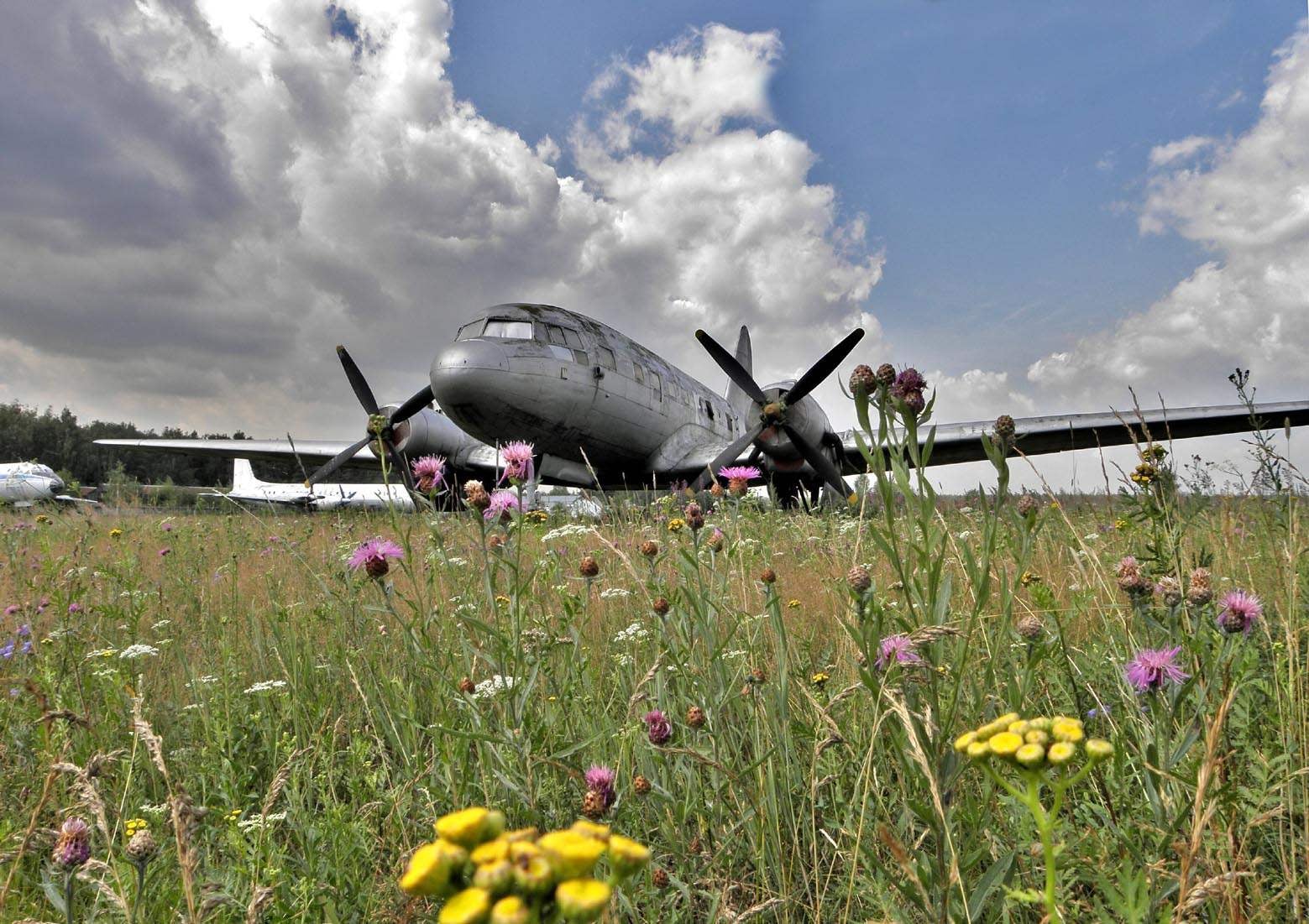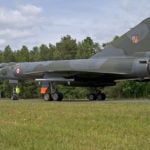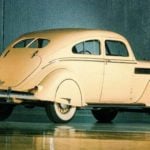 It is natural that interest to the transport plane, superior in its basic parameters of Li-2, has long mastered the air force showed the military. March 11, 1947 issued a decree of the Council of Ministers of the USSR, OKB-240 was instructed to build on the basis of passenger Il-12 and transfer in July 1947, the state tests a troop transport plane with the specified characteristics (see table).
It is natural that interest to the transport plane, superior in its basic parameters of Li-2, has long mastered the air force showed the military. March 11, 1947 issued a decree of the Council of Ministers of the USSR, OKB-240 was instructed to build on the basis of passenger Il-12 and transfer in July 1947, the state tests a troop transport plane with the specified characteristics (see table).
According to the design documentation of OKB-240 on the plant № 30 was built two Il-12 with engines AL-82FN and propellers AV-9E-91. The aircraft (serial number 30034) has entered the state tests 30 July 1947 as a military transport variant. He was fitted with a crane 1500 kg, installed at the opening cargo door. To move cargo around the cabin had a removable hand winch with a pulling force of 250 kg.
Crane equipment was absent at the aircraft factory No. 30064 designed to tow heavy gliders Yak-14 and TS-25 and the release of paratroopers. In its rear fuselage mounted towing lock, designed for the airframe weight up to 7 t and in the cargo compartment was mounted cables for attaching tethers and exhaust parachutes.
These differences in the design of aircraft exhaust. From standard passenger Il-12 military-transport version differed metal floor, laid on a frame structure of the fuselage, and reinforced at this place by four U-shaped profile for ease of rolling heavy loads.
The aircraft factory No. 30064 metal floor covered with rubber, the raft was located 2 rows of 18 metal seats for paratroopers; planting was through the door in the starboard side opened from the inside of the fuselage. On the left side has fulfilled the cargo door (dimensions 2400×1600 mm), consisting of two valves, opening outwards. At the rear the wing mounted landing door (size 900×1525 mm); in flight she was held locks and starred in the airdrop.
Under the center of both aircraft was mounted on two beams with the locks of DER-20, designed for the suspension of loads up to 1 ton each. Despite the differences in the configuration of both machines are slightly different in mass: the first unladen — 10 850 kg, the second -10 820 kg
Given that aircraft do not fully comply with the requirements of regulation (for example, no terms of reference as provided by the shielded turret), they could not be recommended to the GK NII VVS for adopting and tested by special programs. On military cargo variant was determined with performance characteristics, features propeller group and special equipment; he was loaded and placed various loads and equipment. By the way, I tested the possibility of loading three cars “Willis”, 57-mm antitank gun ZIS-2 and a car “Willis” with gunner, various military personnel in cargo containers weighing up to 3 tons
On the second machine worked out glider towing C-25 and assessed suitability for use in airborne; were flying with glider C-25 in tow, in which were determined the performance characteristics of the glider trains: normal takeoff weight of 20.4 tons (of which aircraft accounted for 16.2 tonnes and glider — 4.2 t); the length of the run with nominal power of motors — 730 m take — off distance- 1940 ft; climb 4 miles — 32 minutes. The ceiling was 4.3 km away, while his set — 50 minutes. Towing glider trains were made at speeds up to 240 km/h — maximum level specifications for airframe C-25.
In horizontal flight, after the uncoupling of the cell in a constant mode of operation of the engine of the tow plane, the speed of the Il-12 was increased by 50 — 60 km Technical range of towing flight at an altitude of 1 km at the optimum air speed of 220 km/h (with the refueling aircraft towing 2500 kg fuel) amounted to 1200 km, 925 km less for the same plane without a glider in the same conditions.
According to test results, it was concluded that it was necessary to consider (OKB-240 for presentation to the state tests of the aircraft, meet the requirements of the Regulations. Noted the following deficiencies in the design submitted to the test machines:
equipment for external sling and cargo dropping are not provided by the nodes for containment of spread in the transverse direction;
there was no sight to accurately drop cargo;
electroradiator is not located in the crew cabin and cargo doors, which ruled out the sighting operation;
seats for paratroopers appeared to be very high, causing dorsal chute rested against the side of the cargo compartment and the paratroopers were forced to sit on the front half of the seat;
left the landing the door was impossible to close in flight (it took 2 — 3 people);
in the Windows of the cargo compartment is not made access holes with plugs for firing personal weapons;
cables for attaching the tethers and exhaust parachutes had a lot of slack.
It was also recommended to introduce the equipment of Il-12 personnel gangways, since their replacement with alternatives from scrap materials is not safe and required is not always available at hand.
Have the tow plane with serial No. 30064 subject to addressing the following shortcomings:
- when flying a hard day, and at night it is impossible to monitor the glider through the astronomical dome;
- there was no hatch to signal to the glider pilot;
- side navigation lights and light points on the wing of the aircraft provides the pilot the airframe orientation relative to the tug.
In 1948 on the state tests in GK NII VVS was given Il-12 in a troop transport variant, which partially eliminated the above mentioned disadvantages. This time to fly the Il-12 (serial No. 30172), made 30 December 1947, instructed the lead engineer captain N. G.Savchenko and lead test pilot hero of the Soviet Union guards major V. K. PRECISIO. The flights were conducted in April — may 1948.
Externally, the new Il-12 differed from its predecessor raised astrolyka mounted on a cylindrical base. On the plane still lacked a shielded turret, it was mounted on the subsequent models with factory No. 30174. By the way, the access holes with plugs for firing of personal weapons introduced later (Il-12 serial No. 30201).
During testing, the aircraft No. 30172 were evaluated and the characteristics of the glider Yak-14 (serial number 640101), released by plant No. 464 in January 1948. It was piloted by the famous glider pilot A. I. Pyetsukh. To tow a glider used a tether length of 100 m and a diameter of 14 mm. Flight weight 35-seat Yak-14 was 2 tons more than the 25-seater C-25, therefore, a normal takeoff weight of aircraft towing is limited to 15 t, despite the fact that the total mass of glider trains increased to 21.2 T.
The length of the runway towing a glider with the use of the afterburner increased to 850 m (use high mode reduced the run-up to 9.5%). Length takeoff distance increased to 2375 m. the climb 4 km amounted to 36.8 minutes. The ceiling remained at the same level of 4200 m, and a time of 43 minutes. When the cutaway of the glider in horizontal flight speed of the tow increased to 80 — 85 km/h at constant operation mode of the motors. The maximum speed at which the towed glider Yak-14 was not greater than 265 km/h, which would be his limit.
In the absence of turrets on the plane with serial No. 30172 the practical range of the glider train was determined on Il-12 serial No. 30174. According to test results when towing the instrument at an optimum speed of 200 km/h at an altitude of 1 km, she made: when refueling aircraft towing 2500 kg of fuel — 1150 km (950 miles less than the airplane with no glider) and 1410 km at the gas station 3000 kg of fuel. The range of aircraft No. 30174 when towing a glider Yak-14 to the optimum mode was 720 km (when refueling the tow 2500 kg of fuel), and speed of the train withstands 200 km/h, and the return of the tug were carried out at speeds of 230 km/h.

Il-12:
1 —astrochuppa; 2 — frame RPKO-10M; 3 — antenna of the radio station RSB-bis 3 AD; 4 — on-Board crane with lifting capacity of 1,5 t; 5 — door in the starboard side; 6 — air intake heater BO-10; 7 — window for observing the towed glider; 8 — fold loading door; 9 — the door in the cargo fold; 10 — blister Navigator; 11 — air intake ventilation system of the cabin; 12 — exhaust ventilation system of the cabin; 13 — sentry UTK; 14 — hole for firing personal weapons; 15 back wall (frame No. 8) of the cockpit; 16 — pilot’s seat; 17 — NACA ring; 18 — a hinged lid middle part of the hood; 19 — suction nozzle of the motor; 20 — valve suction pipe; 21 — side a removable cover the rear of the bonnet; 22 — leather strip; 23 — skirt; 24 — rear part of the nacelle; 25 — valve oil cooler; 26 — lower cowl with the oil cooler tunnel; 27 — air inlet of the heat exchanger; 28 — heat exchanger; 29 — water outlet exhaust gas heat exchanger; 30 — actuators UT-3 damper control start-up air; 31 — the intake of heated air into the wing; 32 — pipe exhaust manifold of the motor; 33 — antenna radio SRC-269G; 34 — transitional insulator antenna input; 35 — operational hatch; 36 — mast antenna; 37 — frame LP21A in the fairing; 38 — absorber antenna; 39 — antenna RPCOM; 40 — insulator 41 —rubber safety caps; 42 — cluster bomb rack; 43 — bomb FAB-500 M46; 44 — sash bombolyuka; 45 — Communicator flap RCI-6; 46 — umformer RU-11A (radio RCI-6); 47 receiver RSI-6МУ; 48 transmitter RSI-6; 49 — the receiver of US-1; 50 — a transmitter SCR-3 bis HELL; 51 — aerial ammeter RSB-3 bis AD; 52 — indicator SRC-269G; 53 — handling the remote control SSR-3 bis AD; 54 — subscriber’s apparatus SPOOF-4 radio operator; 55 —umformer RU-11A (SPOOF-4); 56 — umformer RU-11A (for receiver US-1); 57, 59 — junction box SPOOF-4; 58 — umformer HANDS-300A (RSB-3 bis BP); 60 — amp SPOOF-4; 61 — relay box SRC-269G; 62 —umformer, RPKO-10M; 63 receiver, RPKO-10M; 64 — beam holder
The results of these tests it was recognized that Il-12 in this embodiment can be used as troop transport aircraft. For the implementation of a series it was necessary to address the deficiencies identified during the tests, and in particular:
through the window of the elevated astrolyka it was possible to observe the towed glider, but excluded review in the direction at an angle of 90°;
from watching through the window there was no support under the feet or seat;
the handle control cutaway the tow rope was located uncomfortable and did not allow the observer or pilot to make an immediate cutaway, of a glider in an emergency.
12 APR 1948 came the Decision of the USSR on the development of Il-12D and a passenger aircraft. In August 1948, the test pilot V. K. Kokkinaki flew the prototype of the machine, and at the end of September it was transferred to the state tests.
The main difference between Il-12D from previous versions was the ability to not only deliver paratroopers, but bombed. For this purpose, the fuselage in front of and behind the center section could be installed 4 cluster bomb racks designed for a maximum load of 4 tons, or 8 bombs FAB-500. For their discharge into the fuselage had two bomb Bay dimensions 800×2100 mm. For precision bombing and accurate relief goods in blister in the workplace of the Navigator established a night reflex sight COMAR-7, and in the floor of his cabin — day the sight OPB-1R. Blister, moreover, allowed the Navigator to perform duties in the workplace, and not on the chair right of the pilot, as it was on previous versions.
Il-12D retained under the center of the hardpoints cargo pod that could be used for an external suspension bracket of bombs. The fuselage retained the turret with a 12.7 mm machine gun UBT. But it was not installed on all production machines, as not all were and the loopholes in the portholes for firing personal weapons from landing To facilitate loading through hinged doors, the hatch in the left side has supplied additional area; the equipment consisted of a metal ramp to load equipment. The plane was mass-produced from late 1948 until the end of production of “twelfth”.
In 1948 began the delivery of Il-12 in the troop transport version in combat units. First they got 3rd division of the transport-landing aircraft (TDA) in Belarus and 6 — in Ukraine. For them on new machines rearmed 12 Tula and Pskov division.
Pilots first started flying in Il-12 in the Arctic: in April 1948, he participated in works nsra based at Cape Schmidt. Il-12 was completed with mixed crews: additionally included three instructors: pilot, Navigator and radio operator. He was a senior pilot-instructor of the nsra. In a year 8 crews TDA performed the flights to ensure the polar stations.
The main characteristics of the Il-12

In March — April, 1950, two trains gliding (Il-12D with glider C-25 in tow) was launched from the airfield near Moscow Chkalovsky. The Crew Of Hero Of The Soviet Union A. N. Haritashya towed glider A. B. Frolov; V. D. homeland plane was flying in a glider V. D. Shmelev. The flight Chkalovsky — Kazan — Sverdlovsk — Omsk — Krasnoyarsk — Podkamennaya Tunguska river — Khatanga — Tiksi — Ostrov Kotelny station “North pole-2” led by A. Girko. Flights of the Soviet gliding trains in the Arctic lasted until 1954.
If nominal capacity of 38 troopers with weapons in combat units, as a rule, loaded no more than 20. Probably, it was affected by the restrictions imposed on the passenger version of the Il-12. The transfer of weapons of airborne troops on Il-12 could only be performed with the landing aircraft, so in the second half of the 1950s he was forced out of airborne more modern machines with turboprop engines that are more responsive to the increased capabilities of the airborne infantry. But after the rearmament of the Military transport aviation Il-12 continued to serve in auxiliary units and as a utility transport in the army. In the 1960-ies of the “twelve” was used as a training in Balashovskogo vvaul, where they made their “career” in 1967.
For all its virtues Il-12 was not able to displace Li-2 for the airlines of the country. Li-2 were still made by the Tashkent aircraft plant Chkalov until the end of 1953., and, sometimes, twice the production of Il-12. And only Il-14, continuing the direction of Il-12 and devoid of its shortcomings, was able to solve this problem. But without the “twelfth”, to determine the main direction of the work of OKB Ilyushin, it is difficult to imagine the history of this world famous team and national aviation after the Second world war.
Troop-transport aircraft Il-12
Maximum speed, km/h:
earth…………………………………………366
at a height of 2 km………………………………407
The climb of 5 km/min……….15,8
Service ceiling, km………………….7
The length of the run, m……………………………..475
Flight range at a height of 2 km with a load of 3 t
at a speed of 325 km/h, km………….2000
Model the download.
lying (wounded)…………………………27
troopers with weapons…………..37
The maximum transportable cargo, kg………………….3000
Cargo cabin dimensions, m: length x width x height…………………….. 10,88×2,67×1,945
Weapons…………….one point fire from 12.7-mm machine gun with fire from the upper hemisphere



